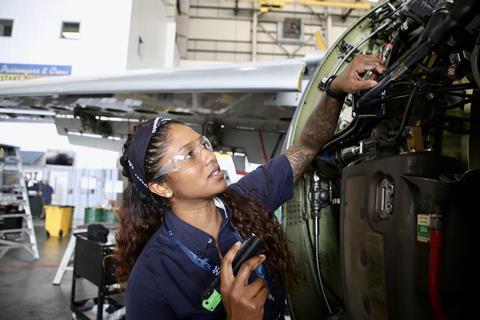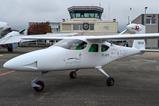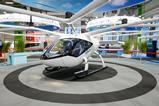US airlines, desperate to fill thousands of pilot, flight attendant, mechanic and other positions, came to Long Beach, California last week to recruit at the world’s largest convention targeted at an underrepresented group: women.
According to the Federal Aviation Administration’s airman certification statistics, in 2022 just 6.3% of all certified pilots in the USA were female. Of all air transport pilot certificate holders – the flight-deck crew members qualified to work in commercial aviation – just 4.9% are women. Among aviation mechanics, that number is 2.8%.
With a looming shortage of skilled workers in aviation and aerospace, companies are scrambling to fill their pilot ranks, but also applicants for mechanic and engineering roles are in short supply. At this year’s Women in Aviation International (WAI) conference, more than 200 companies and institutions – including 15 major legacy, regional and specialty carriers, airframers Boeing, Airbus and Gulfstream, engine makers, technology companies and all US military branches – were tripping over themselves to woo applicants to boost their employee ranks.
“It’s a buyer’s market,” Justin Ritter, senior manager of pilot hiring programmes at United Airlines, told FlightGlobal on 25 February. “I certainly think that before and during Covid a lot of people were tired, and left the industry. We all knew that flying was going to come back, but I don’t think anyone expected how quickly it was going to come back.”

“United had really good foresight, we didn’t retire any widebodies, we brought our entire fleet back. So I think we were well prepared, but from a labour perspective, we had to ramp up really, really quickly,” he adds. United is looking to hire at least 2,500 pilots in 2023, he says, after adding a similar number last year.
Ritter says United’s representatives spoke to about 400 potential candidates during the three-day WAI conference.
And with that ramp-up, companies competing for the same limited pool of talent are looking to groups that have traditionally been under-represented in the industry.
“Women haven’t always been afforded the same opportunities as men to pursue their interests and show off their skills and abilities in the aviation industry,” says Delta Air Lines’ Lorel Roehl, general manager for talent acquisition. “Traditionally, we’ve always thought of flight attendants as being a woman-focused job. But women have a lot more skills and talent and experience. Whether it’s flying, whether it’s being a mechanic, or a frontline agent, we just feel as a company that is right for them to have a voice at the table and to show what they can do.”
EDUCATE
JetBlue Airways first officer and pilot recruiter Danielle Voss says women often do not know what options they have in the aviation and aerospace industries until they attend events like WAI. JetBlue has said it plans to hire more than 500 pilots in 2023.
“We’re here to represent. We are here to educate,” Voss says. “We have an interview room here, so if a candidate is qualified and meets our minimums, we have the option to complete their interview here today and give them a conditional job offer.”
JetBlue was represented at the conference by employees from across numerous work groups, and it sees women as integral to its long-term growth plans, Voss says.
“It’s a wonderful opportunity to be able to give back to not just the aviation community, but to women, and to try to create a safe space, a comfortable space. And just to celebrate this minority within the aviation industry,” she adds.
“As we are coming out of Covid, we have seen that we’ve got to reach out to more people,” Delta’s Roehl says. She cites Boeing’s latest pilot and technician outlook report, in which the airframer predicts the industry will need 602,000 new pilots and 610,000 new maintenance technicians in the next 20 years.
“So as a company, if we don’t think smart about how we reach more people to bring them into the fold, then we’re not going to be successful. The aviation industry as we know it is going to become defunct,” Roehl says.
QUALITY OF LIFE
And in the post-Covid-19 business environment, recruiters have also noticed a marked shift in what those people are looking for.
“A lot of people are interested in quality of life right now,” says Alaska Airlines’ San Francisco-based chief pilot Kimberly Gabrelcik. “It isn’t so much, ‘Hey, I want to fly widebodies across the ocean’ anymore. But rather, people are asking, ‘What’s the quality of life? What’s the culture? What are the people like that I’m going to go to work with every day?’”
Recruiters know it will take more than one WAI conference to boost the supply of qualified professionals in the industry. But showing off what career paths are available, and giving potential candidates the chance to talk to other women already successfully pursuing those careers, is one big step in the right direction.
“Even as far as we’ve come as a society, unless you see someone who looks like you, you don’t necessarily know that it’s an opportunity for you,” Gabrelcik says.
“It comes down to that exposure – you don’t know what you don’t know,” JetBlue’s Voss adds. “And you don’t know what’s possible until you see others do it. You care about their stories and hear how they achieved it, and how they got to where they are now.”
Anything is possible, she says. And her most important piece of advice for female candidates about to step into a traditionally male-dominated industry: “Never be afraid.”
Updates on 3 March to correct the spelling of Lorel Roehl’s name.


















































